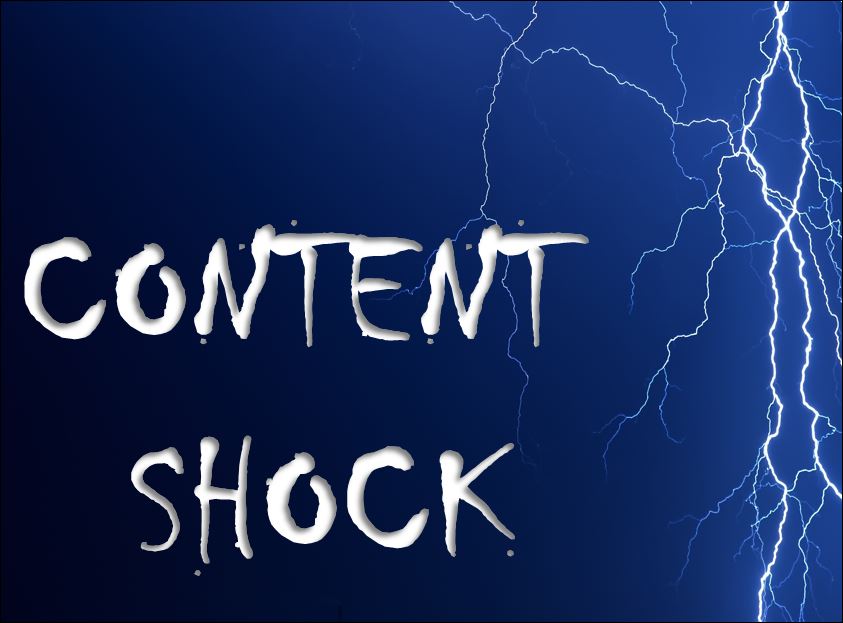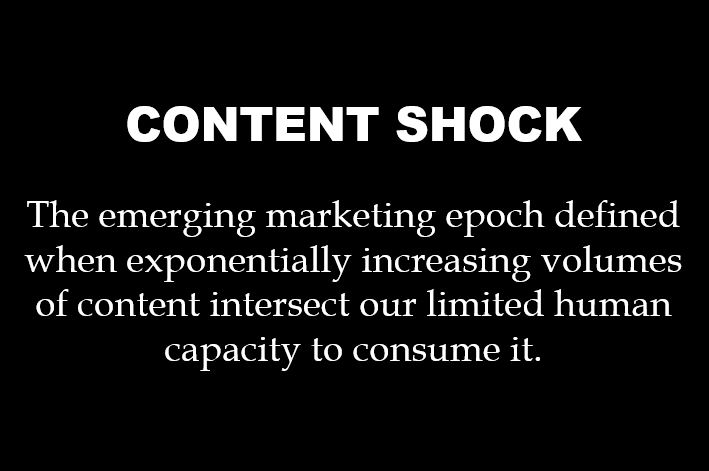By Mark Schaefer
This post will demonstrate in simple economic terms why content marketing — the hottest marketing trend around — may not be a sustainable strategy for many businesses.
Like any good discussion on economics, this is rooted in the very simple concept of supply and demand. When supply exceeds demand, prices fall. But in the world of content marketing, the prices cannot fall because the “price” of the content is already zero — we give it away for free. So, to get people to consume our content, we actually have to pay them to do it, and as the supply of content explodes, we will have to pay our customers increasing amounts to the point where it is not feasible any more.
Paying people to read our content? Does that sound crazy? But you’re already doing it. Let me explain.
You are “paying” people to read your content
When I got my very first company laptop computer (a brick-like device called a GRID) I eagerly plugged it into the phone line and took my first step on to the Internet with that unforgettable AOL screech-and-hiss of a connection sound.
I explored the meager content offerings and found a file with NASA photographs. I clicked on a link and over a period of 10 minutes, a photograph began to download onto my screen.
This was a tremendously exciting breakthrough and I called out to my wife and children “Quick! Come see this! I’m getting a photograph right through the telephone line!”
At that time, the seemingly miraculous ability to access a piece of content — any content at all — was a thrill. We were starved for content and stared with wonder at literally anything we could obtain through this new electronic conduit.
Fast forward to 2009, the year I became a serious content creator. At that point, the web was still a relatively uncrowded “content space.” Red Bull was a beverage company, not a media company, Chipotle was making burritos, not clay-mation films, and there were roughly one-third as many bloggers as there are now … not to mention podcast producers, video-makers, Pinterest pinners, Facebook posters, and Instagram photographers.
Let’s say that in 2009 I spent five hours a week creating content that would be consumed by my blog readers. This was a happy time because not only was the content competition weak, consumption was dramatically increasing too — more people were piling on to the web, on to social media, and on to mobile devices that extended the amount of time each day they could consume content.
For argument’s sake, let’s value my time at $100 per hour. So with 5 hours of content creation in 2009, I was “paying” my readers $500 in my time to consume my content each week. The value I was receiving in return from new business connections far exceeded that investment, so this made good economic sense.
The content model falls apart
Let’s fast forward one more time to 2014 and look at the two factors that impact the economics of content marketing — the amount of content available and the amount of content consumed (supply and demand).
Of course the volume of free content is exploding at a ridiculous rate. Depending on what study you read, the amount of available web-based content (the supply) is doubling every 9 to 24 months. Unimaginable, really.
However, our ability to consume that content (the demand) is finite. There are only so many hours in a day and even if we consume content while we eat, work and drive, there is a theoretical and inviolable limit to consumption, which we are now approaching.
This intersection of finite content consumption and rising content availability will create a tremor I call The Content Shock. In a situation where content supply is exponentially exploding while content demand is flat, we would predict that individuals, companies, and brands would have to “pay” consumers more and more just to get them to see the same amount of content.
And that is exactly what is happening.
I know that you are under a barrage of distractions from increasingly amazing content. For me to simply maintain the “mindshare” I have with you today on this blog, I am going to have to create significantly better content, which of course will take significantly more time. I will probably have to pay Facebook and others to give you a chance to even see it because of this content competition for attention.
I will have to “pay” you at much higher rates just to keep the same number of readers in 2015 that I had in 2014.
Let’s look at this in graphical terms:

According to Nielsen and other sources, the amount of content we consume on a daily basis has grown from two hours a day in the 1920s to nearly 11 hours per day today. Propelled by mobile devices, the average amount of content we consume on a daily basis has gone up by two hours a day just in the last three years!
How much higher can this go? 12 hours a day? 13? Who knows. But there is some limit.
On the supply side of the equation, the amount of information on the web is expected to increase by 500 percent (conservatively) in the next five years. If you can imagine how big the Internet is, in the next five years, we are going to have five of those.
Do you think it is going to be a little more difficult to be successful in content marketing?
Content Shock is here
This upward trend of content consumption is not sustainable because every human has a physiological, inviolable limit to the amount of content they can consume. I believe as marketers, we have been lulled into a false sense of security thinking that this consumption trend will continue to rise without end. That is simply not possible. The Content Shock is coming and I believe we are beginning to enter the danger zone now.
Every single content producer, every marketer, and every business is standing at this same cliff to some degree, and the implications are vast.
1) Deep pockets win
First, as each new media channel has emerged, it is originally fueled with crude “local” content but the eventual winners are the content creators with the deepest pockets. When television started, for example, the airwaves were filled with local programming (kind of like the bloggers of their day!) who created cooking shows, game shows and variety shows using local talent. Today, there is virtually no “local” content consumed on TV, as the corporations have taken over.
If you examined a list of the most popular YouTube videos five years ago, they were “locally-produced” home movies. Today the most popular videos are dominated by big names and big brands producing slickly-produced films and music videos.
Over time, the low budget content producers are eased out of the consumer mindshare as we “pay” more for their attention.
The idea that “great content rises to the top” is over. We are in an era where advertising, promotion, and distribution strategies may eclipse the importance of the content itself.
2) The entry barriers become impossibly high
We see the deep pockets trend occurring in even the smallest market niches. The companies that can overwhelm the market with content can effectively raise the entry hurdles for competitors and maybe even block them out of key search results entirely. Essentially, winning marketers create Content Shock for their competitors!
So the second implication of Content Shock is that barriers to market entry will become impossibly high for many businesses. In 2009 it was pretty easy to start a blog and get a few readers because there just were not that many content producers around. Supply was low, demand was high. How does a small company build an audience today from a standing start in this era of Content Shock? That task is getting more difficult every day.
3) The cost-benefits flip
Finally, the economics created by Content Shock will eventually force many content marketers to adjust their priorities and tactics.
If I was “paying” my readers $500 a week in 2009, I am probably paying them $1,500 per week now because of the pressure to create more and better content that will keep their attention. Next year, it might be $3,000 per week — just to MAINTAIN my readership in the face of the Content Shock. At some point, the amount I am “paying out” will exceed the amount I am bringing in and at that point, creating content will not be a smart business decision for me and many other businesses.
A few months ago, Facebook provided a glimpse of the economics of Content Shock in its business blog when it bluntly stated that the exploding amount of content competing for views in users’ news feeds is making it increasingly difficult for brands to get their content delivered organically to their fans.
According to research by AgoraPulse, the average organic reach on Facebook for a brand declined by more than 30 percent in the last 12 months. That is a cataclysmic change. Why? Facebook explains that the average user can see more than 1,500 stories in their newsfeed. That is simply too much.
So, they need to severely edit what we see. Starting with brands. And that is Content Shock in action before our eyes. There is too much stuff. So, one way or another, the cost of being successful on Facebook is going up.
And so, it begins. The global warming of content marketing is in view.
Eventually, a “cover the world with content” marketing focus will not be a long-term sustainable strategy for many businesses.
So where do we turn?
Of course content marketing is far from over. How and when the “shock” occurs will vary greatly by business, by industry, by content saturation in a niche, by a lot of other factors. For some the crunch might be years away, for some it is happening now.
Similarly, from the perspective of a consumer, this trend is GOOD NEWS. Companies competing for limited consumer attention means more choice and better content. The impact of Content Shock does not result from consumer “information overload.” It comes from the business implications of fighting through overwhelming content density for a finite level of attention. There’s a big difference.
In the history of marketing, there have always been new frontiers enabled by technological breakthroughs and the visionaries who act first. What is the next area of innovation we need to pioneer when the implications of Content Shock become unbearable?



No comments:
Post a Comment